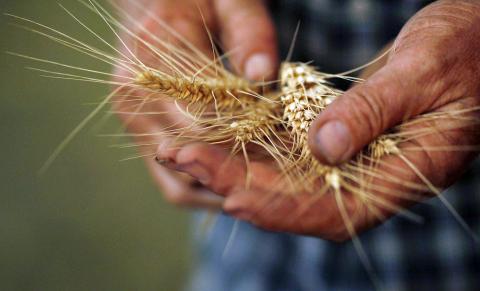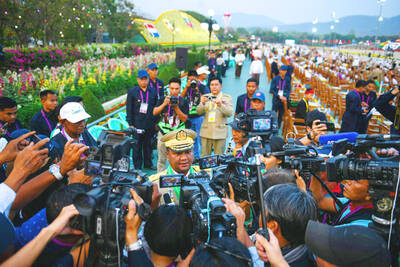Wheat experts are stepping up monitoring of a crop disease first found in Africa in 1999 to minimize the spread of the deadly fungus that is also a threat in Asia, experts said yesterday.
A “Rust-Tracker,” using data supplied by farmers and scientists, could now monitor the fungus in 27 developing nations across 42 million hectares of wheat — an area the size of Iraq or California.
“It’s the most serious wheat disease,” Ronnie Coffman, vice-chair of the Borlaug Global Rust Initiative (BGRI), said ahead of a meeting of wheat experts in Beijing from today until Thursday.

Photo: Reuters
“If it gets started ... it’s like a biological firestorm,” he said.
Experts will review progress in combating the disease, with fungicides and 20 new resistant varieties developed in recent years.
The stem rust disease, forming reddish patches on plants like rust on metal, is known as Ug99 after it was found in Uganda in 1999. It has since spread as far as South Africa and north to Yemen and Iran.
The fungus, which can destroy entire wheat fields, is likely eventually to be carried worldwide on the winds. The biggest threat in coming years is a spread across Asia to Pakistan, India and China, the world’s top producer, Coffman said.
“Effective control often depends on finding out what is happening in distant regions, and the Rust-Tracker can help scientists assess the status of stem rust and other rust diseases,” said Dave Hodson, the developer of Rust-Tracker.
About 85 percent of wheat now in production worldwide was reckoned to be vulnerable to Ug99 and its variants, the BGRI estimated. Rich nations are far less vulnerable because they can afford to switch to new varieties or deploy fungicides.
Afghanistan, Bangladesh, Ethiopia, Egypt, India, Kenya, Nepal and Pakistan are on the front line of deploying rust-resistant varieties.
Coffman said that relatively minor amounts of wheat output had been lost so far.
“The only country under immediate threat of a dramatic loss of production is Ethiopia,” he said.
In Kenya, for instance, Ug99 had largely been brought under control because of shifts to new varieties. Another threat was from yellow rust, which has struck nations from Morocco to Uzbekistan in recent years.
The Ug99 fungus is among a series of threats to food supplies. A UN panel of scientists says heat waves, floods and droughts — like the one affecting the US — are likely to become more frequent because of manmade climate change.
Scientists were also studying ways to limit a woody plant known as barberry, where the fungus also lives and efforts to eradicate the plant seem to have reduced rust.
Coffman said that rust had been known at least since Roman times. About 40 percent of the US crop was destroyed in the early 1950s when rust swept up from Mexico.

Eleven people, including a former minister, were arrested in Serbia on Friday over a train station disaster in which 16 people died. The concrete canopy of the newly renovated station in the northern city of Novi Sad collapsed on Nov. 1, 2024 in a disaster widely blamed on corruption and poor oversight. It sparked a wave of student-led protests and led to the resignation of then-Serbian prime minister Milos Vucevic and the fall of his government. The public prosecutor’s office in Novi Sad opened an investigation into the accident and deaths. In February, the public prosecutor’s office for organized crime opened another probe into

RISING RACISM: A Japanese group called on China to assure safety in the country, while the Chinese embassy in Tokyo urged action against a ‘surge in xenophobia’ A Japanese woman living in China was attacked and injured by a man in a subway station in Suzhou, China, Japanese media said, hours after two Chinese men were seriously injured in violence in Tokyo. The attacks on Thursday raised concern about xenophobic sentiment in China and Japan that have been blamed for assaults in both countries. It was the third attack involving Japanese living in China since last year. In the two previous cases in China, Chinese authorities have insisted they were isolated incidents. Japanese broadcaster NHK did not identify the woman injured in Suzhou by name, but, citing the Japanese

RESTRUCTURE: Myanmar’s military has ended emergency rule and announced plans for elections in December, but critics said the move aims to entrench junta control Myanmar’s military government announced on Thursday that it was ending the state of emergency declared after it seized power in 2021 and would restructure administrative bodies to prepare for the new election at the end of the year. However, the polls planned for an unspecified date in December face serious obstacles, including a civil war raging over most of the country and pledges by opponents of the military rule to derail the election because they believe it can be neither free nor fair. Under the restructuring, Myanmar’s junta chief Min Aung Hlaing is giving up two posts, but would stay at the

YELLOW SHIRTS: Many protesters were associated with pro-royalist groups that had previously supported the ouster of Paetongtarn’s father, Thaksin, in 2006 Protesters rallied on Saturday in the Thai capital to demand the resignation of court-suspended Thai Prime Minister Paetongtarn Shinawatra and in support of the armed forces following a violent border dispute with Cambodia that killed more than three dozen people and displaced more than 260,000. Gathered at Bangkok’s Victory Monument despite soaring temperatures, many sang patriotic songs and listened to speeches denouncing Paetongtarn and her father, former Thai prime minister Thaksin Shinawatra, and voiced their backing of the country’s army, which has always retained substantial power in the Southeast Asian country. Police said there were about 2,000 protesters by mid-afternoon, although